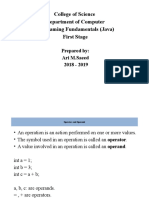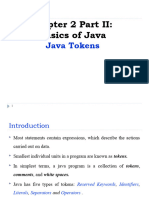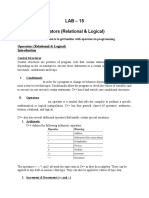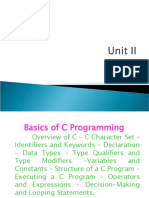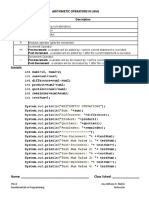Java Programming
Java Tokens & Data types
Identifiers
• Can’t be keywords
• Case-sensitive
• Begin with and consist of:
– Letters (a... Z)
– Numbers (0…9) Same as C++
– Underscore (_)
– Dollar sign ($)
Primitive Types
• boolean 8 bits (1 byte)
• char 16 bits (2 bytes)
• byte 8 bits (1 byte)
• short 16 bits (2 bytes)
• int 32 bits (4 bytes)
• long 64 bits (8 bytes)
• float 32 bits (4 bytes)
• double 64 bits (8 bytes)
Guaranteed to occupy same number of bits regardless of
platform
Strings
• Java defines the String class to handle strings
• A String is a collection of characters treated as
a single unit
• It is not an array of char variables
• Multiple String constructors
String s1 = new String(“Hello World”);
String s2 = “Hello World”;
Type Casting
• Assigning a value of one type to a variable of
another type is known as Type Casting.
• Syntax:
dataType variableName = (dataType) variableToConvert;
• Type casting are of two types they are
– Implicit Casting (Widening)
– Explicit Casting (Narrowing)
Implicit Casting in Java /
Widening / Automatic type conversion
• Automatic type conversion can happen if both
type are compatible and target type is larger
than source type.
Explicit Casting in Java / Narrowing
• When you are assigning a larger type to
a smaller type, then Explicit Casting is
required.
standard default values
In Java, every variable has a default value. If we don’t initialize a
variable when it is first created, Java provides default value to that
variable type automatically as shown in below table
Data Type Default Value (for fields)
byte 0
short 0
int 0
long 0L
float 0.0f
double 0.0d
char ‘u0000’
String (or any object) null
boolean false
Java – Operators and Expressions
• The symbols which are used to perform logical and
mathematical operations in a Java program are
called Java operators.
• These Java operators join individual constants and
variables to form expressions.
• Operators, functions, constants and variables are
combined together to form expressions.
• Consider the expression A + B * 5. where, +, * are
operators, A, B are variables, 5 is constant and A +
B * 5 is an expression.
Types of operators:
• Java language offers many types of operators.
They are,
– Arithmetic operators
– Assignment operators
– Relational operators
– Logical operators
– Bit wise operators
– Conditional operators (ternary operators)
– Increment/decrement operators
– Special operators
Arithmetic Operators in Java:
• Arithmetic operators are used to perform
mathematical calculations like addition,
subtraction, multiplication, division and
modulus in Java programs.
S.no Arithmetic Operators Operation Example
1 + Addition A+B
2 – Subtraction A-B
3 * multiplication A*B
4 / Division A/B
5 % Modulus A%B
Assignment Operators in Java
• In Java programs, values for the variables are
assigned using assignment operators.
Operators Example Explanation
Simple assignment
= sum = 10 10 is assigned to variable sum
operator
+= sum += 10 This is same as sum = sum + 10
-= sum -= 10 This is same as sum = sum – 10
*= sum *= 10 This is same as sum = sum * 10
Compound assignment
/+ sum /= 10 This is same as sum = sum / 10
operators
%= sum %= 10 This is same as sum = sum % 10
&= sum&=10 This is same as sum = sum & 10
^= sum ^= 10 This is same as sum = sum ^ 10
Relational operators in Java
• Relational operators are used to find the
relation between two variables. i.e. to
compare the values of two variables in a Java
program.
S.no Operators Example Description
1 > x>y x is greater than y
2 < x<y x is less than y
3 >= x >= y x is greater than or equal to y
4 <= x <= y x is less than or equal to y
5 == x == y x is equal to y
6 != x != y x is not equal to y
Logical operators in Java
• These operators are used to perform logical
operations on the given expressions.
S.
Operators Name Example Description
no
logical
1 && (x>5)&&(y<5) It returns true when both conditions are true
AND
logical It returns true when at-least one of the
2 || (x>=10)||(y>=10)
OR condition is true
It reverses the state of the operand
logical “((x>5) && (y<5))”
3 ! !((x>5)&&(y<5))
NOT If “((x>5) && (y<5))” is true, logical NOT
operator makes it false
Bit wise operators in Java
• These operators are used to perform bit
operations. Decimal values are converted into
binary values which are the sequence of bits
and bit wise operators work on these bits.
x y x|y x&y x^y Operator_symbol Operator_name
0 0 0 0 0 & Bitwise_AND
0 1 1 0 1 | Bitwise OR
1 0 1 0 1 ~ Bitwise_NOT
1 1 1 1 0 ^ XOR
<< Left Shift
>> Right Shift
Conditional or ternary operators in Java
• Conditional operators return one value if condition is
true and returns another value if condition is false.
• This operator is also called as ternary operator.
• Syntax :
(Condition? true_value: false_value);
• Example:
(A >100 ? 0 : 1);
In above example, if A is greater than 100, 0 is returned
else 1 is returned. This is equal to if else conditional
statements.
Increment/decrement Operators in Java
• Increment operators are used to increase the
value of the variable by one and decrement
operators are used to decrease the value of the
variable by one in Java programs.
• Syntax:
Increment operator:
++var_name; (or) var_name++;
Decrement operator:
--var_name; (or) var_name--;
• Difference between pre/post increment &
decrement operators in Java:
S.no Operator type Operator Description
++i Value of i is incremented before
1 Pre increment
assigning it to variable i.
i++ Value of i is incremented after assigning
2 Post–increment
it to variable i.
--i Value of i is decremented before
3 Pre decrement
assigning it to variable i.
i-- Value of i is decremented after assigning
4 Post_decrement
it to variable i.
Operator precedence & associativity
• Java operators have two properties those are
precedence and associativity.
• Precedence is the priority order of an operator, if
there are two or more operators in an expression
then the operator of highest priority will be
executed first then higher, and then high. For
example, in expression 1 + 2 * 5, multiplication (*)
operator will be processed first and then addition.
It's because multiplication has higher priority or
precedence than addition.
Evaluation Order of an Expression
• In Java when an expression is evaluated, there
may be more than one operators involved in
an expression. When more than one operator
has to be evaluated in an expression Java
interpreter has to decide which operator
should be evaluated first. Java makes this
decision on the basis of the precedence and
the associativity of the operators.
Mathematical Functions
• min(x,y)- Returns the minimum of the two values x and y
• max(x,y)- Returns the maximum of the two values x and y
• sqrt(x)- Returns the rounded positive square root of a value.
• pow(x,y)- Returns the value of x raised to the power of y (xy).
• exp(x)- Returns e raised to the power of x (ex).
• round(x)- Returns the closest integer to the argument x.
• abs(x)- returns the absolute value of x.
Decision making & looping
• In decision control statements, group of
statements are executed when condition is
true. If condition is false, then else part
statements are executed.
• There are 3 types of decision making control
statements in Java language.
– if statements
– if else statements
– nested if statements
Decision Syntax Description
control
statements
if if (condition) In these type of statements, if
{ Statements; } condition is true, then respective
block of code is executed.
if…else if (condition) In these type of statements, group
{ Statement1; Statement2; } of statements are executed when
else condition is true. If condition is
{ Statement3; Statement4; } false, then else part statements are
executed.
if else if ladder if (condition1) If condition 1 is false, then
{ Statement1; } condition 2 is checked and
else_if(condition2) statements are executed if it is
{ Statement2; } true. If condition 2 also gets
else failure, then else part is executed.
Statement 3;
Loop control statements
• Loop control statements in Java are used to
perform looping operations until the given
condition is true. Control comes out of the
loop statements once condition becomes false.
• There are 3 types of loop control statements in
Java language.
– for
– while
– do-while
Loop
S.no Syntax Description
Name
1 for for (exp1; exp2; expr3) Where,
{ exp1 – variable initialization
statements; ( Example: i=0, j=2, k=3 )
} exp2 – condition checking
( Example: i>5, j<3, k=3 )
exp3 – increment/decrement
( Example: ++i, j–, ++k )
2 while while (condition) where,
{ condition might be a>5, i<10
statements;
}
3 do while do where,
{ condition might be a>5, i<10
statements;
}while (condition);
switch case statement in Java
Switch case statements are used to execute only specific case
statements based on the switch expression. Below is the syntax
for switch case statement.
switch (expression)
{
case label1:
statements;
break;
case label2:
statements;
break;
default:
statements;
break;
}
break statement in Java
Break statement is used to terminate the
while loops, switch case loops and for
loops from the subsequent execution.
Syntax:
break;
Example program for break statement in Java:
importjava.lang.*; import java.io.*;
class brstmt
{
public static void main(String args[])
{
int i; Output:
for(i=0;i<10;i++) 01234
{ Coming out of for loop when i = 5
if(i==5)
{
System.out.println(“\nComing out of for loop when i = 5”);
break;
}
System.out.println(““+i);
}
}
}
Continue statement in Java
Continue statement is used to continue the
next iteration of for loop, while loop and do-
while loops. So, the remaining statements are
skipped within the loop for that particular
iteration.
Syntax : continue;
Example program for continue statement in Java:
importjava.lang.*; import java.io.*;
class constmt
{
public static void main(String args[])
{
int i;
for(i=0;i<10;i++)
{
if(i==5 || i==6)
{
System.out.println(“\n Skipping from display using continue
statement \n”+i);
continue; Output:
01234
} Skipping 5 from display using continue statement
System.out.println(““+i); Skipping 6 from display using continue statement
} 789
}
The return statement in Java
The return statement is used to explicitly
return from a method. That is, it causes
program control to transfer back to the caller
of the method.
Example program for return statement in Java
class ReturnStatement
{
public static void main(String arg[])
{
boolean t = true;
System.out.println("Before the return"); // LINE A
if(t)
return; // return to caller
System.out.println("This won't execute"); // LINE B
}
} OUTPUT
Before the return
Nested loops in Java
• The placing of one loop inside the body of
another loop is called nesting. When you
"nest" two loops, the outer loop takes control
of the number of complete repetitions of the
inner loop. While all types of loops may
be nested, the most commonly nested
loops are for loops.
OUTPUT
0 0
0 1
0 2
1 0
1 1
1 2
2 0
2 1
2 2
3 0
3 1
3 2
Labeled Loops
• According to nested loop, if we put break
statement in inner loop, compiler will jump
out from inner loop and continue the outer
loop again. What if we need to jump out from
the outer loop using break statement given
inside inner loop? The answer is, we should
define label along with colon(:) sign before
loop.
Syntax of Labelled loop
for-each version of the for loop
• It is mainly used to traverse array or collection
elements. The advantage of for-each loop is
that it eliminates the possibility of
programming error and makes the code more
readable.
• Syntax of for-each loop:
for(data_type variable : array or collection)
{ }
Example of for-each version of the for loop
class ForEachExample1
{
public static void main(String args[])
{
int arr[]={12,13,14,44};
Output
for(int i:arr)
:
{ 12
System.out.println(i); 13
} 14
} 44
}
Questions
1. Describe any two relational and any two logical operators in Java with
simple example.
2. Write general syntax of any two decision making statements and also
give its examples.
3. Write a program to check whether an entered number is prime or not.
4. Explain break and continue statements with example.
5. State syntax and describe working of ‘for each’ version of for loop with
one example.
6. Define a class having one 3-digit number as a data member. Initialize
and display reverse of that number.
7. Explain any four features of Java.
8. Describe ?: (Ternary operator) in Java with suitable example.
9. Explain any two bit-wise operators with example.
10. What is byte code? Explain any two tools available in JDK.
11. What is JVM? What is byte code?
12. ‘?:’ what this operator is called ? Explain with suitable example.
1. Write a program to accept a number as command line argument and print
the number is even or odd.
2. Define JDK. List the tools available in JDK explain any one in detail.
3. Explain: 1) Platform independence 2) Compiled and interpreted features of
Java.
4. Write any four mathematical functions used in Java.
5. Write a program to find sum of digits of number.
6. What do mean by typecasting? When it is needed?
7. Write a program to generate Fibonacci series : 1 1 2 3 5 8 13 21 34 55 89.
8. Write a program to print reverse of a number.
9. List eight data types available in java with their storage sizes in bytes.
10. Describe typecasting with one example.
11. What is meant by instance variable and static variable? Describe with
example.







































